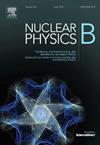集成集体动力学:无暗分量引力动力学的纯理论标量张量框架
IF 2.8
3区 物理与天体物理
Q2 PHYSICS, PARTICLES & FIELDS
引用次数: 0
摘要
我们提出了集成集体动力学(ICD),这是一种受复杂系统中涌现现象启发的新型标量张量理论,它为跨星系和宇宙尺度的引力动力学提供了一个统一的纯理论框架,而不需要调用暗物质或暗能量。集成集体动力学将引力系统概念化为相互作用的粒子的集合,其中集体相互作用由巨大的标量场介导,产生对引力的紧急修改。在牛顿极限下,集成集体动力学采用严格推导的修正函数来重现平坦的星系旋转曲线,通过统计力学启发的方法消除了对暗物质的需要。在相对论上,我们将集成集体动力学表述为具有精心构造的作用的标量张量理论,通过变分原理推导场方程并在各种制度下解析求解它们。标量场自然地诱导宇宙加速,取代暗能量,并预测引力透镜、宇宙微波背景和结构形成的定性修正。新增内容包括对旋转曲线的定量预测,与其他理论的比较,以及对模型局限性的讨论。这些基于微扰理论、渐近分析和严格数学推导的预测,突出了集成集体动力学重塑我们对引力理解的潜力。基于场论和统计力学,集成集体动力学为ΛCDM范式提供了一个数学上优雅的替代方案,解决了关于引力微观起源及其与量子力学潜在统一的基本问题。本文章由计算机程序翻译,如有差异,请以英文原文为准。
Integrated collective dynamics: A purely theoretical scalar-tensor framework for gravitational dynamics without dark components
We propose Integrated Collective Dynamics (ICD), a novel scalar-tensor theory inspired by emergent phenomena in complex systems, to provide a unified, purely theoretical framework for gravitational dynamics across galactic and cosmological scales without invoking dark matter or dark energy. Integrated Collective Dynamics conceptualizes gravitational systems as ensembles of interacting particles, where collective interactions, mediated by a massive scalar field, produce emergent modifications to gravity. In the Newtonian limit, Integrated Collective Dynamics employs a rigorously derived correction function to reproduce flat galactic rotation curves, eliminating the need for dark matter through a statistical mechanics-inspired approach. Relativistically, we formulate Integrated Collective Dynamics as a scalar-tensor theory with a meticulously constructed action, deriving field equations via variational principles and solving them analytically in various regimes. The scalar field naturally induces cosmic acceleration, supplanting dark energy, and predicts qualitative modifications to gravitational lensing, the cosmic microwave background, and structure formation. New additions include quantitative predictions for rotation curves, comparisons with alternative theories, and discussions of model limitations. These predictions, grounded in perturbation theory, asymptotic analysis, and rigorous mathematical derivations, highlight Integrated Collective Dynamics's potential to reshape our understanding of gravity. Rooted in field theory and statistical mechanics, Integrated Collective Dynamics offers a mathematically elegant alternative to the ΛCDM paradigm, addressing fundamental questions about the microscopic origins of gravity and its potential unification with quantum mechanics.
求助全文
通过发布文献求助,成功后即可免费获取论文全文。
去求助
来源期刊

Nuclear Physics B
物理-物理:粒子与场物理
CiteScore
5.50
自引率
7.10%
发文量
302
审稿时长
1 months
期刊介绍:
Nuclear Physics B focuses on the domain of high energy physics, quantum field theory, statistical systems, and mathematical physics, and includes four main sections: high energy physics - phenomenology, high energy physics - theory, high energy physics - experiment, and quantum field theory, statistical systems, and mathematical physics. The emphasis is on original research papers (Frontiers Articles or Full Length Articles), but Review Articles are also welcome.
 求助内容:
求助内容: 应助结果提醒方式:
应助结果提醒方式:


